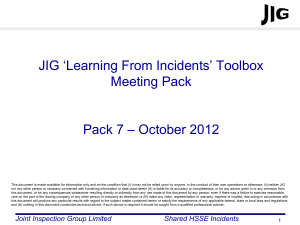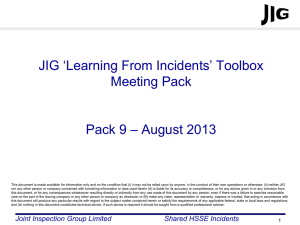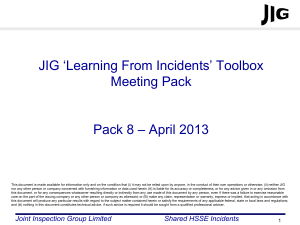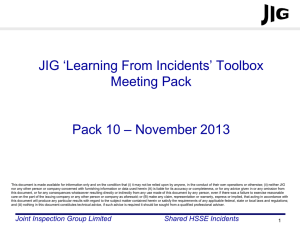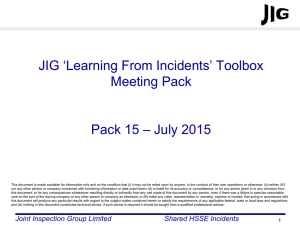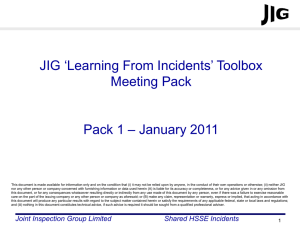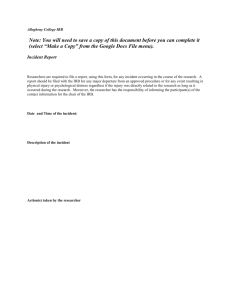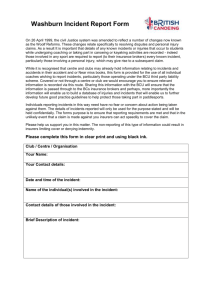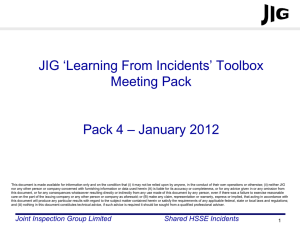JIG LFI Toolbox Pack 16 - Joint Inspection Group
advertisement
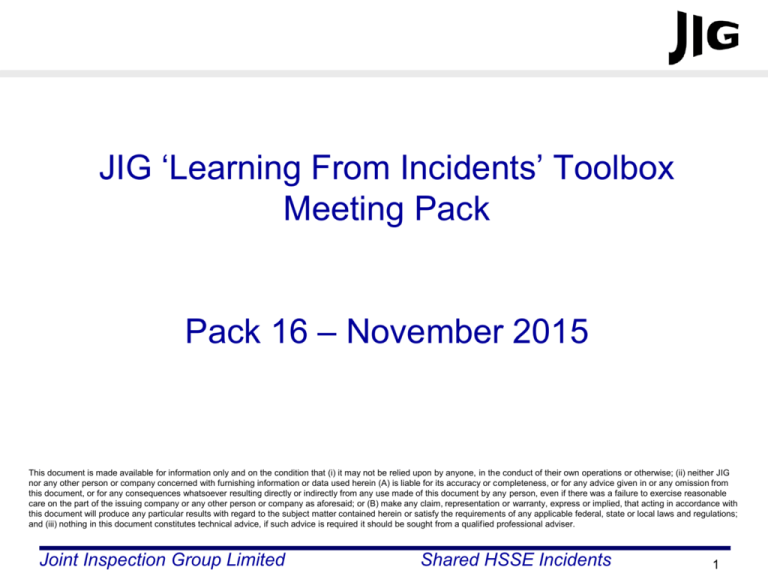
JIG ‘Learning From Incidents’ Toolbox Meeting Pack Pack 16 – November 2015 This document is made available for information only and on the condition that (i) it may not be relied upon by anyone, in the conduct of their own operations or otherwise; (ii) neither JIG nor any other person or company concerned with furnishing information or data used herein (A) is liable for its accuracy or completeness, or for any advice given in or any omission from this document, or for any consequences whatsoever resulting directly or indirectly from any use made of this document by any person, even if there was a failure to exercise reasonable care on the part of the issuing company or any other person or company as aforesaid; or (B) make any claim, representation or warranty, express or implied, that acting in accordance with this document will produce any particular results with regard to the subject matter contained herein or satisfy the requirements of any applicable federal, state or local laws and regulations; and (iii) nothing in this document constitutes technical advice, if such advice is required it should be sought from a qualified professional adviser. Joint Inspection Group Limited Shared HSSE Incidents 1 Learning From Incidents How to use the JIG ‘Learning From Incidents’ Toolbox Meeting Pack • The intention is that these slides promote a healthy, informal dialogue on safety between operators and management. • Slides should be shared with all operators (fuelling operators, depot operators and maintenance technicians) during regular, informal safety meetings. • No need to review every incident in one Toolbox meeting, select 1 or 2 incidents per meeting. • The supervisor or manager should host the meeting to aid the discussion, but should not dominate the discussion. • All published packs can be found in the publications section of the JIG website (www.jigonline.com) Joint Inspection Group Limited Shared HSSE Incidents 2 Learning From Incidents For every incident in this pack, ask yourselves the following questions: • What is the potential for a similar type of incident at our site? • How do our risk assessments identify and adequately reflect these incidents? • What prevention measures are in place and how effective are they (procedures and practices)? • What mitigation measures are in place and how effective are they (safety equipment, emergency procedures)? • What can I do personally to prevent this type of incident? If you would like further assistance or information relating to the information contained in this pack please contact JIG via http://www.jigonline.com/contacts/ Joint Inspection Group Limited Shared HSSE Incidents 3 Lost Time Injury LFI 2015-09 Incident Summary – An Operator sustained an injury to his back and ribs after his left leg gave way as he was descending a Hydrant Servicer telescopic ladder that connected the elevating fuelling platform to the fixed lower level vehicle platform. After visiting hospital he was advised to take time off work to recover. Causes – • The Operator had a previous medical condition with his left knee that had not been disclosed to his employer. The Operator sustained an injury 15 years prior to the incident and had surgery to rectify the problem allowing him to carry out his normal duties. • The Operator had been experiencing some discomfort before the incident but did not report this. He was determined that this discomfort should not impair his ability to carry out his duties. • The norm at the location is for the fuelling platform to be raised to provide support for the refuelling hoses while connected to the aircraft. However, a Pantograph, designed to provide this support , is installed on this vehicle. Although implemented with good intentions, raising the platform unnecessarily introduced an additional risk of climbing up and down the telescopic ladder. Discussion Points – • Discuss Fitness to Work requirements with your Operators. Fuelling aircraft is a physically demanding job. A culture of openness should be encouraged to allow site personnel to advise on personal medical issues that may affect their ability to safely carry out their activities without fear of a negative response. For example, reporting and addressing Musculo Skeletal Disorders early may prevent a more serious injury later on. • If your location has Hydrant Servicers equipped with a Pantograph, discuss the system with your Operators. Are they fully aware of how the system works and what it is designed to achieve? Is there a consistent approach to Hydrant Servicer fuelling at your location? Can you think of any similar situations that YOU have experienced or witnessed? Did you report it? Joint Inspection Group Limited Shared HSSE Incidents 4 High Potential Incident – Overwing Fuelling LFI 2015-10 Incident Summary – An Operator fuelled a DA42 aircraft with Jet A-1. The following morning the aircraft owner notified the operations room that the fuel cap on the port wing tank had been left off. Following heavy rain the previous night, it was suspected that rain water may have contaminated the fuel in the tank. This was subsequently emptied and replenished with fresh fuel. Causes – • The fuel cap on the port wing was found not to be in position. However, the investigation did not establish the root cause. The Operator stated that he could not remember not replacing the cap and that he had followed the correct overwing fuelling procedure. • It is possible that another party may have opened the cap as the aircraft was left on the apron over night. But this cannot be substantiated as there was no CCTV footage or independent witnesses. Tool box Discussion Points – • Always follow procedures and avoid complacency. This aircraft type had been fuelled a number of times on that day by the same operator. Procedures are developed where strong controls are required to protect from misfuelling or product quality risks. • Re-enforce with all operators that the correct fuelling sequence should always be followed. • Think about control barriers and the critical role operators play in ensuring that controls and barriers work as intended. Do you carry out overwing fueling operations? Could this happen at your location? What control barriers do you have in place to ensure this does not happen (think equipment barriers; human barriers etc.) and how do you ensure your barriers are functioning as intended? Can you think of any similar situations that YOU have experienced or witnessed? Did you report it? Joint Inspection Group Limited Shared HSSE Incidents 5 Loss of Primary Containment LFI 2015-11 Incident Summary – A 2.8m3 ISO container was overfilled resulting in a 1.6 m3 LOPC (Loss of Primary Containment) incident (Jet A-1). The overfilled product was contained in the site interceptor and recovered. There was no spill to the environment and there were no injuries. Causes – • The pre-set meter had failed so did not shut off the flow of product as intended. The Operator advised that he did not check that the meter was counting down once the filling process had commenced. The pre-set meter had been checked and calibrated annually. • The overfill prevention device had not been installed in the tank as required by the ISO tank filling procedure. This has to be manually installed in the tank by the operator. The Operator could not explain why he had omitted to carry out this vital aspect of the process. • The filling operation was left unsupervised as the operator had gone for shelter due to heavy rain and wind (18mm fell that day). The ISO container could not be observed from this position. Discussion Points – • Always follow procedures. Procedures are developed where strong controls are required to protect operators from harm when performing complex or high-risk tasks and/or for situations with no tolerance for errors. Distractions can cause key procedural steps to be missed. If you get distracted, use the “Stop, Think Do” philosophy to ensure that sufficient time is taken to check or re-check that key procedural steps have not been missed. • Think about control barriers and the critical role operators play in ensuring that these barriers work as intended. Could this happen at your location when filling storage tanks, fuellers etc? What control barriers do you have in place that will ensure this does not happen at your location (think equipment barriers; human barriers etc.) and how do you ensure your barriers are functioning as intended? • Avoid complacency and an over-reliance on mechanical barriers. This operation had been carried out countless times before with no incidents of this nature. Always check that mechanical barriers are working as intended. Can you think of any similar situations that YOU have experienced or witnessed? Did you report it? Joint Inspection Group Limited Shared HSSE Incidents 6 Manual Handling Injury LFI 2015-12 Incident Summary – Following the submission of near miss reports regarding stiffness of some tank valves in a depot a project was commenced to complete the installation of new valves. Stem extension handles were fitted as an aid to Manual Handling activities. Without these extensions, operators would have to bend or kneel down to operate the valves. The project was undertaken by a competent contractor under the permit system and all work fully completed. The facility was handed back to the operator by the airport and contractor. Some days later an operator sustained an injury to his back whilst operating one of the valve stems. Causes – • • • The stem extensions were of an incorrect bore such that when being fully opened the spindles began to jam inside the housing causing resistance. The operator, being used to the resistance of the older valves, continued to apply more force resulting in a muscle strain. The propensity for the spindle to jam in the housing was not experienced on the commissioning trial and therefore not considered during the handover meeting. Discussion Points – • • • • • • Are project completion and handover meetings correctly and diligently completed at your site? Is infrastructure fully tested for serviceability before being placed back into service? Are defective items correctly defected if a problem is noted? Do you continue to operate equipment if you are used to it being difficult to operate? Have you correctly identified manual handling risks within your facility? Does your location complete manual handling training? Can you think of any similar situations that YOU have experienced or witnessed? Did you report it? Joint Inspection Group Limited Shared HSSE Incidents 7 Spill during Bridger discharge activity LFI 2015-13 Incident Summary – • A spill occurred during a Bridger discharge operation when an underground tank was overfilled due to miscalculation of tank ullage. The hi alarm systems failed to warn or shut off the system resulting in a spill of 690 litres of Jet A1. • Towards the end of the offloading process the Bridger driver heard the High high level alarm and he immediately shut off the Bridger pump and valve, his positioning during the offload meant he was not able to see the hi level alarm beacon flashing. When he looked in the offloading cabinet he could see product flowing out of the tank vent pipe onto the cabinet floor. Causes – • Miscalculation of delivery quantity • No ullage calculations prior to discharge • Bridger discharge operation undertaken without procedures and training. • System was intended for gravity filling not designed to be used for Bridger pump-off • Vent pipe design meant product discharged into fuelling cabinet Discussion Points – • • • Are tank gauges calibrated at your site? How do you check ullage before product receipt? How does your Hi and HiHi level system work, do you test it? Can you think of any similar situations that YOU have experienced or witnessed? Did you report it? Joint Inspection Group Limited Shared HSSE Incidents 8 Hot Brakes when Bonded during refuel of B787 LFI 2015-14 Incident Summary – A recent incident has taken place whilst the bonding cable has been connected to a B787 aircraft bonding spigot. The proximity between the hot brake casing and bonding spigot are very close. On completion of the fuelling when the bonding clip was disconnected it was noticed that the hot brakes, although covered, had caused the protective cable to melt and had been a potential fire hazard during the fuelling operation. Causes – • Aircraft brakes can reach extreme temperatures. Hot brakes are a hazard that are not only a potential fire hazard, but could also result in a personal injury that could cause a serious burn during the bonding sequence. Bonding Spigot Location Discussion Points – Hot Brake Casing • Have you identified and made staff aware of heat sources on an aircraft that have the potential to cause personal injury, equipment damage or pose a fire risk during fueling operations. • Are your equipment checks and inspections robust enough to identify damage such as that caused in this incident or gradual damage caused by persistent heat exposure over a period of time Can you think of any similar situations that YOU have experienced or witnessed? Did you report it? Joint Inspection Group Limited Shared HSSE Incidents 9

